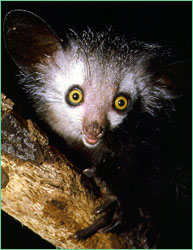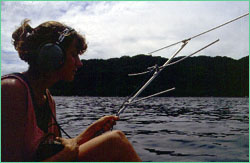 |
Aye-Aye—Eleanor SterlingResearch scientist Eleanor Sterling spent almost two years stumbling through the dark forests of Madagascar in an effort to better understand the aye-eye, perhaps one of the most endangered species on the planet.  NOVA: Can you describe the aye-aye and what makes it unique?
NOVA: Can you describe the aye-aye and what makes it unique?ES: The aye-aye is a primate—the same order that we human beings belong to. It's got continuously growing front teeth like a rodent, it's got large naked ears like a bat, and it's got a long flowing tail like a fox. One of its fingers is extremely thin and probe-like. It's mostly tendon and bone and skin that the aye-aye uses to poke around and grab food from inside of things. Only one other organism in the whole world has this kind of thin, fleshless finger. The aye-aye is also fairly unique in that it's a nocturnal animal and it's really pretty big. It's the size of a house cat and most nocturnal animals, particularly nocturnal primates, are really small. They're more like the size of mice or a little bigger than that. NOVA: What were the greatest challenges that you faced in studying the aye-aye? ES: The biggest initial challenge was being able to find enough information about the animals to design a good study. The second greatest challenge was keeping up with the animals. They move over large areas of land all night and they almost never stop to rest. I was basically walking the whole night.  NOVA: What technology did you use in the field?
NOVA: What technology did you use in the field?ES: I used something called radio telemetry. I put a collar with a radio transmitter on several aye-ayes and then I used a receiver with headphones to follow them at night. NOVA: What did the technology enable you to learn about the aye-ayes that you otherwise wouldn't have been able to learn? ES: The technology I used enabled me to follow the animals even when they disappeared from view. I also got a better idea for what their social behavior was. With radio telemetry, you can identify the animals by just switching the channels and seeing which ones have collars and which ones don't. It helps you to piece together relationships between the different animals and also the activities. NOVA: What did you learn about the social behavior of aye-ayes? ES: We think they're relatively solitary, but I did follow several individuals who seemed to be moving in pairs. One animal would be in a tree feeding and another animal would be in an adjacent tree feeding. And then they would call to each other. They'd make those calls right before one individual moved to another tree—and then the second individual would follow. So it seemed that they were foraging in tandem. That was kind of unusual and something that we hadn't seen before. (back) Photos: (1) David Haring/Duke University Primate Center; (2) Betsy Carlson. Night Vision | Zoology After Dark Resources | Guide | Transcript | Night Creatures Home Editor's Picks | Previous Sites | Join Us/E-mail | TV/Web Schedule About NOVA | Teachers | Site Map | Shop | Jobs | Search | To print PBS Online | NOVA Online | WGBH © | Updated November 2000 |